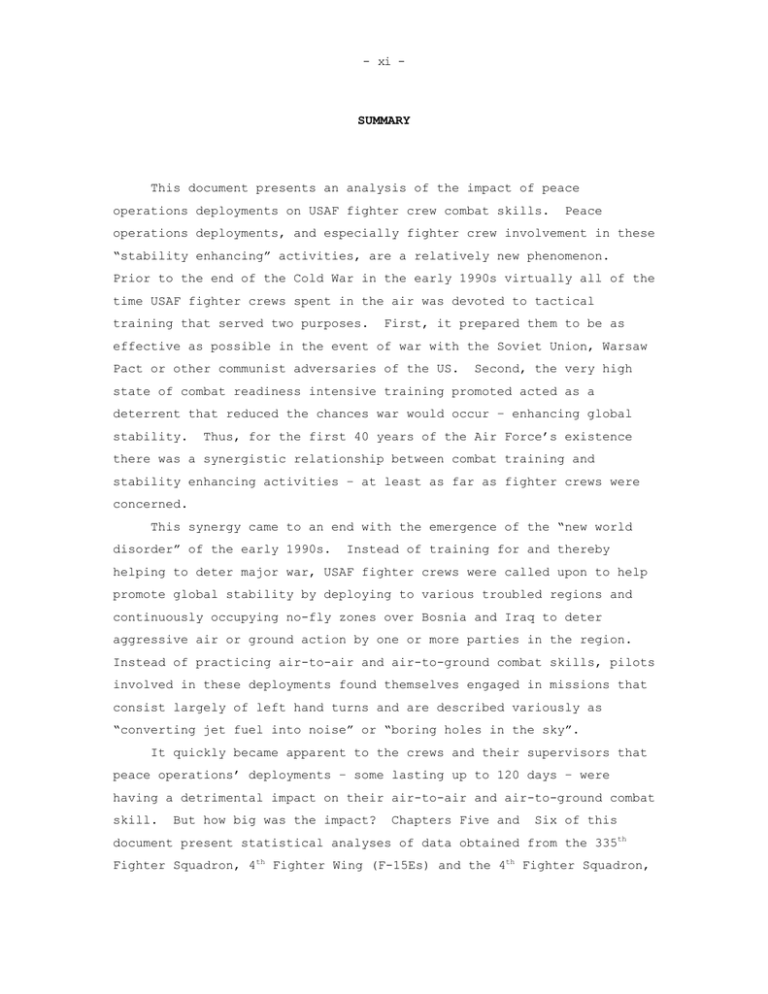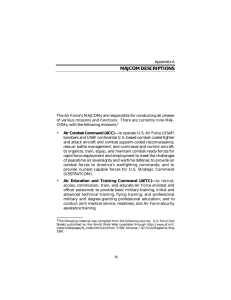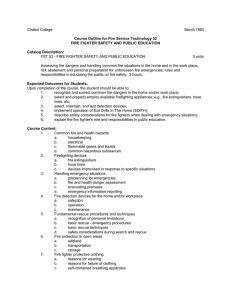- xi - SUMMARY
advertisement

- xi - SUMMARY This document presents an analysis of the impact of peace operations deployments on USAF fighter crew combat skills. Peace operations deployments, and especially fighter crew involvement in these “stability enhancing” activities, are a relatively new phenomenon. Prior to the end of the Cold War in the early 1990s virtually all of the time USAF fighter crews spent in the air was devoted to tactical training that served two purposes. First, it prepared them to be as effective as possible in the event of war with the Soviet Union, Warsaw Pact or other communist adversaries of the US. Second, the very high state of combat readiness intensive training promoted acted as a deterrent that reduced the chances war would occur – enhancing global stability. Thus, for the first 40 years of the Air Force’s existence there was a synergistic relationship between combat training and stability enhancing activities – at least as far as fighter crews were concerned. This synergy came to an end with the emergence of the “new world disorder” of the early 1990s. Instead of training for and thereby helping to deter major war, USAF fighter crews were called upon to help promote global stability by deploying to various troubled regions and continuously occupying no-fly zones over Bosnia and Iraq to deter aggressive air or ground action by one or more parties in the region. Instead of practicing air-to-air and air-to-ground combat skills, pilots involved in these deployments found themselves engaged in missions that consist largely of left hand turns and are described variously as “converting jet fuel into noise” or “boring holes in the sky”. It quickly became apparent to the crews and their supervisors that peace operations’ deployments – some lasting up to 120 days – were having a detrimental impact on their air-to-air and air-to-ground combat skill. But how big was the impact? Chapters Five and Six of this document present statistical analyses of data obtained from the 335th Fighter Squadron, 4th Fighter Wing (F-15Es) and the 4th Fighter Squadron, - xii - 388th Fighter Wing (F-16Cs) to shed some light on this question. The analyses lead to the following conclusions: SHORT TERM IMPACT • Proxy measures for important Major Theater War (MTW) air-to-ground and air-to-air combat skills show a rapid and marked decline during peace operations deployments. • The probability of missing a target with a low level bomb delivery increases dramatically during deployments for non-instructors and for squadrons as a whole. • Probability of miss for F-15E visual and radar bomb deliveries increases, on average, by 25 to 30 percent (from 0.33 to 0.41 for visual and from 0.27 to 0.36 for radar deliveries). • Probability of miss for F-16C visual bomb deliveries increases, on average, by 25 percent (from 0.41 to 0.50). • The probability of launching an invalid air-to-air missile shot during a peace operations deployment doubles compared to normal non-deployed training (from 0.11 to 0.23). • Proficiency returns within a matter of weeks for both air-to-air and air-to-ground combat skills once normal training resumes. • These skill losses are almost certainly associated with decreased proficiency in other important MTW combat skills, so the overall combat effectiveness of USAF fighter crews performing peace operations missions probably declines more, and perhaps much more, than these measures indicate. LONG TERM IMPACT • Anecdotal accounts, backed up by some exit survey evidence, suggest peace operations deployments are significant contributors to a disturbing decline in average USAF fighter crew tactical experience levels. • They contribute in two ways: First, the long family separations and lack of compelling rationale for personal sacrifice contribute to extremely low retention rates for experienced fighter pilots and WSOs. • Second, the near zero tactical training value of the sorties significantly decreases the amount of tactical training crews - xiii - accomplish over the long term – forcing the USAF leadership to choose between a shortage of instructors and flight leads brought on by increased upgrade times, or a de facto lowering of standards for these important positions. There are a variety of ways these problems could be addressed. US national leaders could decide to eliminate one or more of the existing no-fly zone commitments. Alternatively, changes could be made to the nature of the deployments to minimize the detrimental impact they have on USAF fighter crew combat skills. These measures include policies that would alter who deploys, how long they are gone, how many crews and aircraft deploy, various options for increasing training for deployed units and new operational concepts for conducting peace operations. Most of these possible solutions have either already been adopted, or are unattractive for political, financial, or safety reasons. With effective solutions unattractive, dangerous, unlikely, or years away the USAF finds itself on the horns of a real dilemma. On the one hand, there seems to be no slackening of demand for USAF fighter crew participation in stability enhancing peace operations. These operations are an important part of the environment shaping aspects of the current national security strategy and are therefore certainly a part of the “real mission” of the Air Force and other services. On the other hand, these operations have real, non-trivial negative consequences for both the long- and short- term combat readiness of fighter crews who participate in them. These negative effects will almost certainly impact the USAF’s ability to effectively defend US national interests the next time it is called on to conduct a MTW air campaign. In short, there seems to be an inherent conflict between two important USAF missions that did not exist to anything like the same extent during the Cold War, and especially from 1975 to 1990. This research shows that current commitments exceed the USAF fighter forces capacity to simultaneously conduct peace operations and maintain the same training and readiness standards developed during the last 15 years of the Cold War. These training standards are the result of lessons learned and relearned, sometimes the hard way, in combat - xiv - during World War II, Korea and Vietnam. Crews trained to these standards achieved outstanding results during Operation Desert Storm and the public, political leaders, and many in the military have accepted Desert Storm as the standard of performance they expect from American armed forces. With few attractive technological or operational solutions available it seems clear that sooner or later US national leaders must do one of the following: 1) Decrease the commitments USAF fighter forces currently face by bringing one or more of the current peace operations to an end through diplomatic or other means. 2) Increase the capacity of USAF fighter forces to simultaneously conduct peace operations deployments and high quality. OR . . . 3) Continue to accept decreased, and declining, levels of USAF fighter crew MTW combat readiness and the attendant risks of casualties and operational reversals. These are not attractive choices. The first two options have relatively high short term political or fiscal costs. However, it is important to remember that any delay or decision not to decide is in reality a choice to continue to stick with option three – the option that clearly has the highest long run cost.




